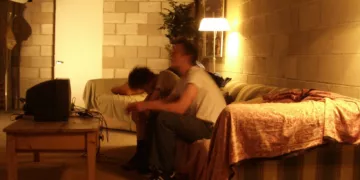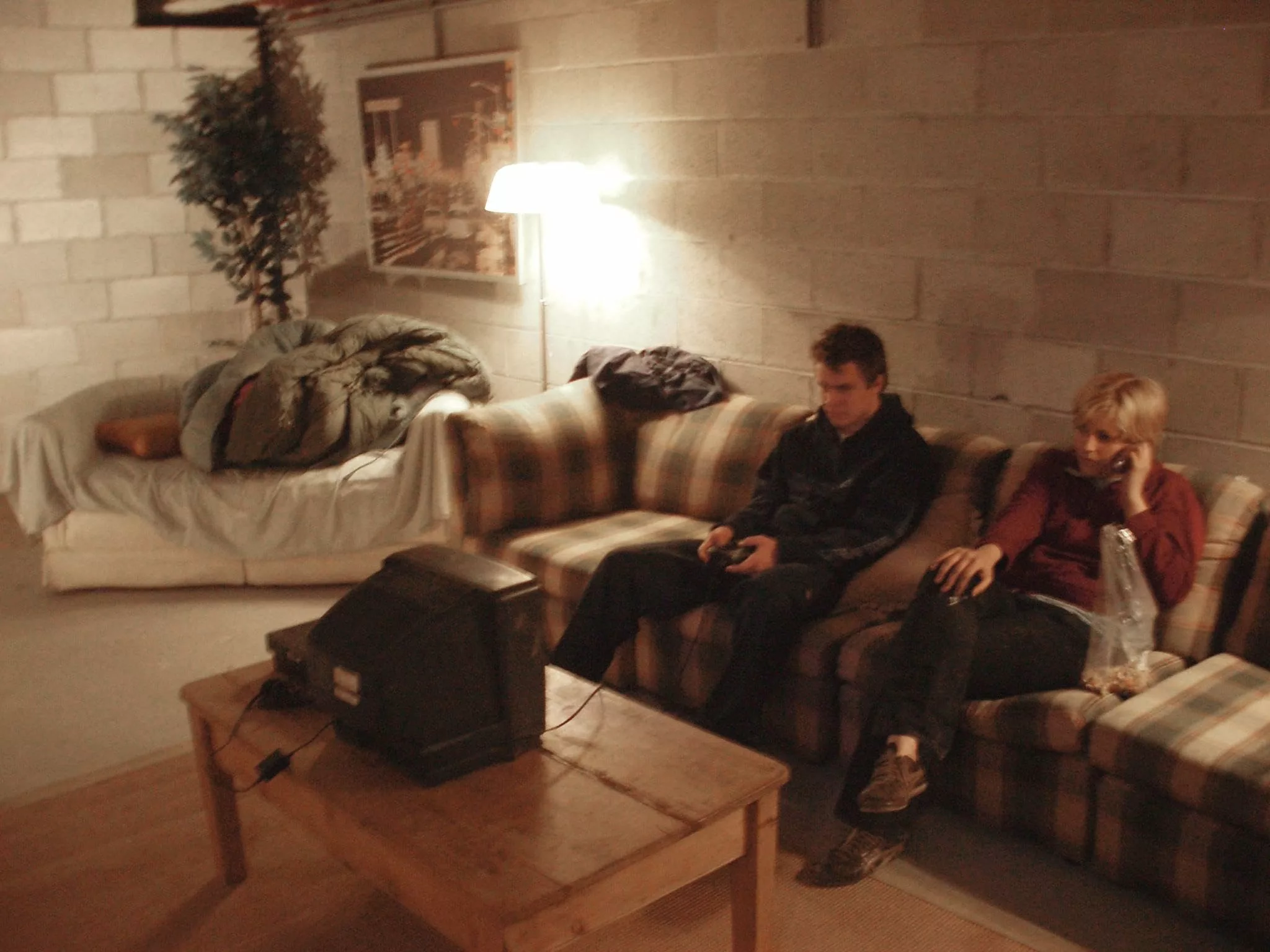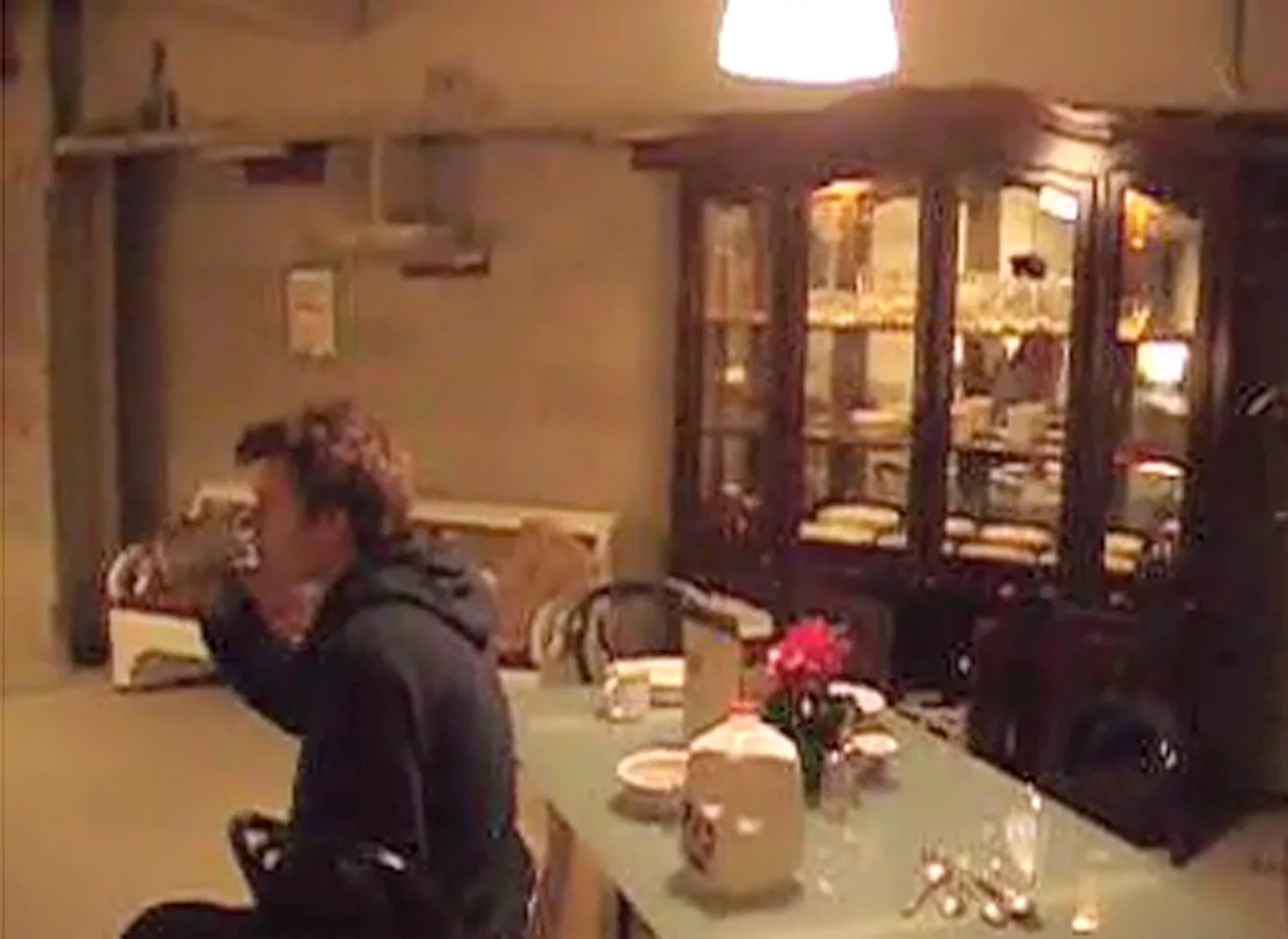At the turn of the new millennium, the city of Providence, Rhode Island, sought to revitalize through an ambitious urban renewal plan. For many hard-working city residents, the construction of the gleaming new Providence Place Mall brought progress and prosperity. But for some in the tight-knit creative community, it marked the loss of their beloved artistic hub, Fort Thunder.
When artist Michael Townsend and seven colleagues discovered hidden space within the very walls of the new mall, they saw opportunity. Over the next four years, they covertly transformed this secret nook into something truly unique—a fully functioning living space and artistic statement.
Directed by Jeremy Workman, Secret Mall Apartment takes viewers inside this unlikely home. Through grainy found footage and modern interviews, we learn how the space slowly evolved. Furniture was carefully hauled in through unlikely openings. Warm lighting and decor brought the drab chamber to life. Together, the inhabitants explored the boundaries of site-specific installation art through everyday living.
Their quiet act of occupation became a playful protest, breathing life back into areas left cold and uninhabited by urban “progress.” Beyond the thrills of unlikely hiding in plain sight, the film celebrates the power of creative community spirit to find meaning even in the unwelcoming places “revitalization” leaves in its wake.
Creative Response to Change
In the late 1990s, Providence underwent significant redevelopment that dramatically altered the landscape for many creatives living there. For decades, a thriving arts community had flourished in Fort Thunder, a former textile mill that artists had transformed into workshops and galleries. However, as the city aimed to revive its downtown corridors, Fort Thunder faced demolition to make way for new condominiums.
Around the same time, the gleaming Providence Place Mall opened its doors with much fanfare. Placed strategically between Olneyville and downtown, some saw the mall as a barrier dividing longtime neighborhoods. To residents on either side, it represented a shift toward consumerism over community. Where old factories once buzzed with industry and creativity, now sprawled acres of storefronts and parking lots.
It was within this context of rapid change that artist Michael Townsend hatched his ambitious plan. Along with seven fellow creatives, he sought to reclaim space in the very symbol of Providence’s redevelopment that had displaced their artistic roots. In 2003, hiding in plain sight within the walls of Providence Place, they began to construct their secret living quarters.
Over four years, this unlikely apartment served as both residence and installation artwork. It allowed its inhabitants to quietly stake their claim in an area growing beyond their influence. Through simple acts of living, they breathed life once more into a sterile nook of concrete. Their creative response brought color and character to what urban planning had rendered cold, impersonal, and out of reach.
Found and Made Their Own
Tucked away in an unused nook within the sprawling walls of the Providence Place Mall, a secret space was discovered that would become so much more. It all began as a casual challenge between Michael Townsend and friends: who could last the longest while living surreptitiously within the shopping complex? Exploring the depths of the building’s infrastructure, Townsend happened upon a secluded pocket untouched since construction.
Far from the bustling corridors, this hidden hollow offered unlikely potential. At first, it served as a temporary retreat, a place for the artists to spend idle hours away from prying eyes. But slowly, inspired imaginations took hold. What if, rather than a passing haven, it became a long-term home on their own terms? So the group began congregating there regularly, gradually outfitting the bare 750-square-foot area with furnishings.
Under Townsend’s documentation, snippets capture the bare-bones charm of those early scenes. Makeshift moves like maneuvering a thrift store sofa several stories on a rickety ladder glimpse the innovative spirit that transformed this void. Shelves and lighting followed, as did pleasantries like a television. All delivered via secretive late nights, these additions chipped away at the clinical essence of the space to mold it into something warm and welcoming.
Before long, what was merely a place to pass time had evolved into lively quarters fully adapted to their needs. Far from the sterile consumer grounds above, the inhabitants cultivated an underground sanctuary under their own creative conditions. Their clandestine colony within the walls was truly making a home where once there was nothing.
Making a Home in Secret
Within the unwelcoming walls of the Providence Place Mall, eight creatives cultivated lively daily routines far from the usual consumer bustle. Having outfitted their found nook into quarters comfortably sleeping five, life in the hidden apartment hummed with activity. Friends frequently gathered for movies or meals scavenged from remnants in the food courts down below. Townsend’s documentation offers a glimpse into how normalcy emerged even in abnormal surroundings.
Throughout, residents juggled precautions to avoid detection. Access meant shimmying supplies through narrow openings under the cover of night. Still, comforts grew as furniture and decorations materialized, and boundaries delineated rooms. Interviews show the diligent labor required to maintain livability: patching walls, fixing leaks, and extending wiring. Despite obstacles, it functioned as fully as any conventional home.
Not that life went undisrupted. Resident Zachary Robbins recounts constant vigilance, wondering, “Is this the night we get caught?” While thrilling, long-term security proved elusive. Townsend’s wife voiced frustrations with the project consuming resources better spent elsewhere. The apartment existed between an artistic statement and a true dwelling; there was no substitute for conveniences elsewhere.
Some saw it merely as a game; others saw it as a protest lodged where impact mattered most. Yet no full-time inhabitants emerged; it uses fluid. Ultimately, discovery ended the demonstration, though its inhabitants went on sculpting provocative works. As Director Jeremy Workman shows, their resourceful reclamation stirred questions left unanswered by sterile redevelopment, placing lived experience over commercialized spaces.
Memorial Art Across Cities
Michael Townsend counted himself among those deeply affected by the September 11th terrorist attacks. Determined to honor each lost soul in his own way, he embarked on a remarkable years-long tribute spanning New York. With adhesive-backed colored tapes, he painstakingly crafted miniature portraits of the deceased outside their places of work or residence.
It was slow, difficult labor transporting supplies and affixing translucent images under the cover of night. But for Townsend, no commemoration felt complete without recognizing individual lives. He persisted even as materials proved transient, exposed to weather, and curious fellow citizens. A website cataloged each portrait before it was lost, preserving that phase of his memorial evolution.
This dedication featured others installing provocative art that stirred the soul. One work wrapped entire mannequin torsos subtly in string, leaving the discovery of what lay within to passersby. Positioned down secluded tunnels, they posed questions on life and mortality through subtlety instead of shock.
Such creative acts served as protests in their own right. When development erased spaces for local expression, the collective found ways to practice activism through their mediums. Reclaiming parts of what was taken and crafting beauty from bleak locations, they challenged prevailing visions and kept alternative perspectives visible. Even unseen by many, their diversity of talents and visions worked to shift the prevailing winds in quiet yet indelible ways.
Questioning Progress
The story of the Secret Mall Apartment illuminates complex tensions between art, identity, and social change. When new construction displaced the collective formerly centered in Fort Thunder, it prompted deeper inquiry into whose visions of “progress” hold sway.
By carving out uncommon space within the imposing structure itself, participants challenged top-down narratives of revitalization. Their reclaimed nook spoke through avant-garde means to how development can other and price out certain perspectives. Was this truly bettering the city, as alleged, if it required erasing prior treasures?
Meanwhile, the apartment grew from a lighthearted dare into a sustained questioning of norms. Living surreptitiously in plain sight made a playful statement, yet the commitment increased purpose. Projects memorializing lives lost on 9/11 and brightening young patients’ days confer deeper motivation beyond subversion for its own sake.
But where does artful provocation end and real provocation begin? Interweaving life, art, and activism tests simple definitions. The film discerns no easy resolutions, respecting complexity. It honors how creativity might advance discourse, even inadvertently, through pushing boundaries with care, vision, and goodwill. Ultimately, it encourages viewing “progress” and community with equal concern and hearing all voices shaping invaluable debates around place, identity, and human flourishing.
Creating Space for Creativity
The Secret Mall Apartment tells an unusual story that stayed with viewers long after. By reclaiming unused areas and making them home, the artists involved shaped narratives on their own terms. Their temporary community protested what new construction displaced in innovative style.
While their secret apartment ended, the film ensured their impact didn’t get bricked in. It celebrates the resilience of the creative mindset that can find purpose anywhere, from hospitals to underground tunnels. We see how artwork doesn’t need official sanction or money shots to meaningfully start dialogue.
Even now, long after leaving the mall, Michael Townsend keeps realizing taped visions that memorialize and bring color. His example shows how innovation thrives on continually questioning what’s possible. The movie deserves credit for bringing such a project to light in a way anyone can relate to and be inspired by.
In the end, perhaps the most lasting effect is inspiring others to view overlooked spaces as potential for imagination and connection. When change comes, creativity will find a way to create room for self-expression and community.
The Review
Secret Mall Apartment
The Secret Mall Apartment tells a uniquely playful yet poignant story about creative reimagining in the face of uncertainty. Director Jeremy Workman crafts a fun yet thoughtful profile of unconventional place-making that celebrates individuality and togetherness. While short in length, this film leaves a lasting impression of resilience through artistic spirit.
PROS
- Inspiring story of creative community and protest
- Fascinating glimpse into a guerrilla art project
- Celebrates thinking outside the box and questioning norms.
- An energetic look at DIY placemaking on a small budget
CONS
- Could have delved deeper into cultural and economic issues.
- Present-day interviews feel a touch perfunctory.
- Lacks context for artists' other meaningful projects


















































